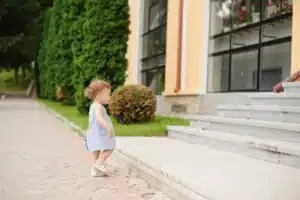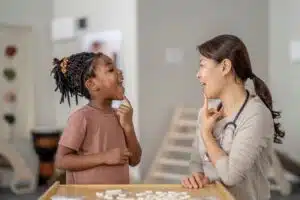By: Rena Mkhitaryan, MS CCC-SLP
Language development is an integral and natural aspect of your child’s growth. Just as each child has a unique personality, their path to language mastery may also vary. Some children adopt a Gestalt Language Processing (GLP) approach, where they absorb and use language in large, meaningful chunks. Others may demonstrate Analytical Language Processing (ALP), focusing on individual words and gradually building up to complex sentences.
Analytic Language Learners:
Approach: Analytic learners primarily acquire language by breaking it down into smaller components. They start with individual words, where each word carries a distinct meaning. Also known as the bottom-up approach.
Progression: Over time, they transition from using single words to constructing two or three-word phrases.
Example: An analytic learner might first learn the word “dog,” then combine it with other words like “big dog” or “nice dog” to express more complex ideas.
Gestalt Language Learners:
Approach: Gestalt learners follow a different path. They process language in larger chunks, focusing on whole phrases or sentences rather than individual words. This can be described as an inverted triangle. Sometimes these phrases can be from a show they watched or overheard (e.g., micky mouse club house, coco melon, Mrs. Rachel)
Stages of Development:
Stage 1: Delayed Echolalia: At this initial stage, gestalt learners use scripted phrases from sources like books or media. For instance, a child might say, “There’s a monkey at the end of this book!”—a gestalt picked up from a beloved story.
Stage 2: Mix and Match (Trimming Down): Here, they break down larger gestalts into smaller chunks. They mix and match parts of phrases to create semi-unique utterances. For example, “There’s a monkey + under there” becomes “There’s a monkey under there.”
Stage 3: Single Words and Two-Word Combinations: Gestalt learners finally identify words as single units of meaning. They create new noun combinations, such as “monkey,” “silly monkey,” or “monkey bed.”
Stages 4-6: In these advanced stages, they construct novel phrases or sentences with more complex grammar.
Both GLP and ALP are recognized and effective methods of language acquisition. Each child’s journey is unique, and they may find success with different techniques tailored to their style. If you’re uncertain about your child’s language processing style, consider embracing a variety of strategies that nurture language skills. Engaging in child-led play therapy, incorporating music and songs, and exploring augmentative and alternative communication (AAC) tools are all excellent ways to support your child’s communication development.
Remember, there’s no single ‘right’ way to learn language. By providing a supportive and rich linguistic environment, you can help your child find their voice and express themselves with confidence.




